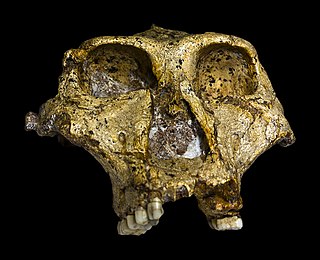 W
WThe Boaz mastodon is the skeleton of a mastodon found near Boaz, Wisconsin, USA, in 1897. A fluted quartzite spear point found near the Boaz mastodon suggests that humans hunted mastodons in southwestern Wisconsin. It is currently on display at the University of Wisconsin Geology Museum.
 W
WThe expression "Giant of Castelnau" refers to three bone fragments discovered by Georges Vacher de Lapouge in 1890 in the sediment used to cover a Bronze Age burial tumulus, and dating possibly back to the Neolithic. According to de Lapouge, the fossil bones may belong to one of the largest humans known to have existed. He estimated from the bone size that the human may have been about 3.50 m tall. No modern peer-reviewed study has been published about the alleged giant bone fragments.
 W
WKNM WT 17000 is a fossilized adult skull of the species Paranthropus aethiopicus. It was discovered in West Turkana, Kenya by Alan Walker in 1985. Estimated to be 2.5 million years old, it is an adult with an estimated cranial capacity of 410 cc.
 W
WMrs. Ples is the popular nickname for the most complete skull of an Australopithecus africanus ever found in South Africa. Many Australopithecus fossils have been found near Sterkfontein, about 40 kilometres (25 mi) northwest of Johannesburg, in a region of the Transvaal now designated as the Cradle of Humankind World Heritage Site. Mrs. Ples was discovered by Robert Broom and John T. Robinson on April 18, 1947. Because of Broom's use of dynamite and pickaxe while excavating, Mrs. Ples's skull was blown into pieces and some fragments are missing. Nonetheless, Mrs./Mr. Ples is one of the most "perfect" pre-human skulls ever found. The skull is currently held at the Ditsong National Museum of Natural History in Pretoria.
 W
WOH 5 is a fossilized cranium and the holotype of the species Paranthropus boisei. It was discovered in Olduvai Gorge, Tanzania, by archaeologist-paleontologist Mary Leakey in 1959. Her husband and fellow scientist Louis Leakey initially classified the hominid as Zinjanthropus boisei and thought that it was an early ancestor of modern humans that lived approximately 2 million years ago. However, this contention was later withdrawn because of its robust australopithecine features and the discovery of Homo habilis soon thereafter.
 W
WThe Peninj Mandible(Peninj 1), also called Natron mandible, is the fossilized lower jaw and teeth of an australopithecine specimen, likely that of Australopithecus boisei or a similar population. It was discovered in West Lake Natron, in the Arusha Region of Tanzania by Kamoya Kimeu, Glynn Isaac, and Richard Leakey in 1964.
 W
WPředmostí 3 was an Upper Paleolithic Homo sapiens from the Czech Republic, geologically dated to the Late Pleistocene.
 W
WSK 46 is the fossilized partial cranium and palate of the species Paranthropus robustus. It was discovered in Swartkrans, South Africa by local quarrymen and Robert Broom in 1949.
 W
WSK 48 is a fossilised skull of the species Paranthropus robustus. It was found at Swartkrans, South Africa, in 1948 by palaeontologist Robert Broom. Estimated to be about 1.8 million years old, it is characterised by a robust appearance, bulging and continuous brow, broad flat face and a deep jaw with large chewing teeth/muscle attachments.
 W
WSTS 14 is a fossilized partial skeleton of the species Australopithecus africanus. It was discovered at Sterkfontein, South Africa by Robert Broom and John T. Robinson in August 1947, and is estimated to be about 2.5 million years old.
 W
WTM 1517 is a fossilized skull and lower mandible of the species Paranthropus robustus. It was discovered at Kromdraai, South Africa in 1938 by Robert Broom.